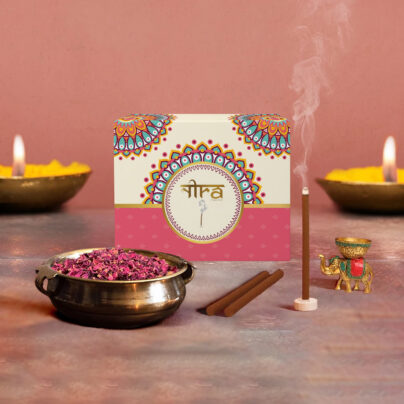Sandalwood incense has captivated humanity for centuries, its warm, woody aroma weaving through spiritual practices, meditative rituals, and everyday moments of calm. Revered for its rich fragrance and cultural significance, sandalwood holds a unique place in the world of incense. This blog explores the origins, benefits, crafting process, and modern uses of sandalwood incense, offering a deep dive into why this timeless scent continues to enchant.
The Origins of Sandalwood Incense
Sandalwood, derived from the Santalum tree, has roots in ancient traditions across Asia, particularly in India, Australia, and parts of Southeast Asia. The heartwood of the sandalwood tree, especially Santalum album (Indian sandalwood), is prized for its creamy, musky scent that lingers long after the incense burns out. Historically, sandalwood was a cornerstone in religious ceremonies, from Hindu and Buddhist rituals to ancient Egyptian embalming practices. Its use in incense dates back thousands of years, with references in sacred texts like the Vedas and Buddhist sutras, where it symbolized purity and divine connection.
The tree itself takes decades to mature, making authentic sandalwood a precious resource. Overharvesting has led to conservation efforts, particularly in India, where sustainable cultivation is now prioritized. This scarcity adds to the mystique of sandalwood incense, making each stick a small piece of nature’s luxury.
Why Sandalwood Incense Stands Out
Sandalwood’s fragrance is distinct for its smooth, velvety warmth, with subtle sweet and earthy undertones. Unlike floral or herbal incenses, sandalwood offers a grounding experience that feels both luxurious and calming. Its scent profile is versatile, blending seamlessly with other fragrances like jasmine or patchouli, yet it shines on its own. This makes it a favorite for those seeking a balanced, non-overpowering aroma.
Beyond its sensory appeal, sandalwood is believed to have therapeutic properties. Aromatherapy experts note that its scent can reduce stress, enhance focus, and promote emotional balance. In traditional Ayurvedic medicine, sandalwood is used to calm the mind and balance the body’s energies. Scientific studies, while limited, suggest that sandalwood’s key compound, alpha-santalol, may have calming effects on the nervous system, making it ideal for meditation or mindfulness practices.
The Art of Crafting Sandalwood Incense
Creating high-quality sandalwood incense is an art form that blends tradition with precision. The process begins with sourcing sustainable sandalwood, often ground into a fine powder to preserve its essential oils. This powder is mixed with natural binders like makko (a bark powder) and water to form a pliable dough. For hand-rolled incense, artisans shape the mixture around bamboo sticks, a method perfected in regions like Mysore, India. For dipped incense, sticks are coated in sandalwood oil blends, though purists argue this dilutes the authenticity.
The best sandalwood incense avoids synthetic fragrances or charcoal, which can produce harsh smoke. Instead, natural ingredients ensure a clean burn, releasing a soft, lingering aroma. The drying process, often done under controlled conditions to lock in the scent, can take days. Premium brands may age their incense to deepen the fragrance, much like fine wine.
Cultural and Spiritual Significance
Sandalwood incense transcends cultures, playing a role in diverse spiritual practices. In Hinduism, it’s burned during puja ceremonies to invoke divine blessings. Buddhist temples use it to create a sacred atmosphere, believed to aid in meditation by clearing mental clutter. In Japan, sandalwood is central to kōdō, the ceremonial art of appreciating incense, where participants “listen” to the scent’s nuances.
Beyond religion, sandalwood holds a universal appeal. Its ability to evoke tranquility makes it a staple in yoga studios, wellness retreats, and homes worldwide. Lighting a sandalwood stick can transform a space, turning a hectic day into a moment of reflection.
Modern Uses and Benefits
Today, sandalwood incense is more than a spiritual tool; it’s a lifestyle accessory. Its calming properties make it a go-to for stress relief, especially in fast-paced urban environments. A single stick can elevate a room’s ambiance, masking odors and creating a warm, inviting atmosphere. For creatives, sandalwood’s focus-enhancing qualities can inspire productivity during work or study sessions.
Environmentally conscious consumers will appreciate that many brands now prioritize eco-friendly practices. Sustainable sandalwood farms and biodegradable packaging reduce the environmental impact, ensuring that this ancient tradition aligns with modern values. Additionally, sandalwood incense burns cleanly when made without synthetic additives, making it a healthier choice for indoor air quality.
Choosing the Right Sandalwood Incense
Not all sandalwood incense is created equal. When selecting, look for brands that use pure sandalwood powder or essential oil rather than synthetic fragrances. Hand-rolled sticks from reputable sources, like those from Mysore or Karnataka, often guarantee authenticity. Check for eco-certifications or transparency about sourcing to ensure sustainability.
Burn time matters too—premium sticks can last 45 minutes to an hour, filling your space with a steady, gentle aroma. Avoid overly cheap options, as they may contain fillers that dilute the scent or produce unpleasant smoke.
How to Use Sandalwood Incense
Using sandalwood incense is simple but requires care. Place the stick in a secure holder, light the tip until it glows, then gently blow out the flame to let it smolder. Ensure proper ventilation to enjoy the fragrance without overwhelming the room. For meditation, light the incense a few minutes before starting to let the scent settle. Store unused sticks in a dry, airtight container to preserve their potency.
The Future of Sandalwood Incense
As demand grows, the incense industry faces challenges in balancing tradition with sustainability. Innovations like lab-grown sandalwood oil or reforestation initiatives are promising steps toward preserving this cherished resource. Meanwhile, sandalwood’s timeless appeal ensures it remains a beloved choice for those seeking serenity in a chaotic world.
In conclusion, sandalwood incense is more than a fragrance—it’s a bridge to history, spirituality, and personal well-being. Whether you’re meditating, refreshing your home, or exploring its cultural roots, sandalwood offers a sensory journey unlike any other. Light a stick, breathe deeply, and let its warm embrace guide you to a place of peace.

[…] 2025, the polo T-shirt evolves with fresh designs and modern sensibilities. Here are the key […]